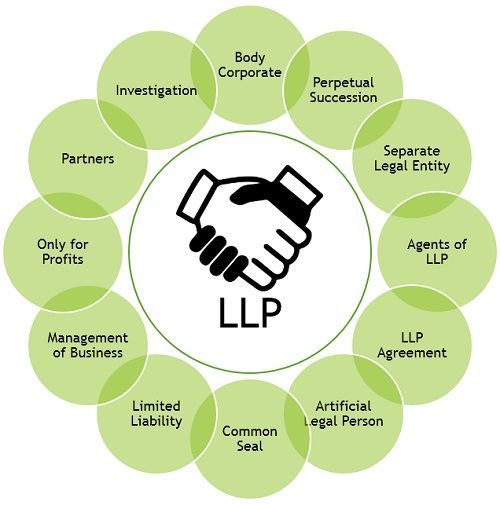Definition: LLP is an acronym for Limited Liability Partnership, which is an emerging form of business organization. It incorporates the features of a Partnership and Body Corporate, as in low compliance cost while allowing the flexibility of a general partnership in terms of internal structure.
In finer terms, LLP is the hybrid form of a company and partnership.
Salient Features of Limited Liability Partnership
The salient features of the Limited Liability Partnership (LLP) are discussed below:
- Body Corporate: A Limited Liability Partnership (LLP) is a body corporate, founded under the Limited Liability Partnership Act, 2008. Being a corporate entity, the incoming and outgoing of the partners do not affect the LLP.
- Perpetual Succession: By the term ‘perpetual succession’ you can easily interpret that LLP continues to exist perpetually, no matter if the partners are changed in the long run. This means that death, retirement, insolvency of any of the partners won’t hinder partnership.
- Separate Legal Entity: LLP is a separate legal entity, means it has a separate corporate identity in the eyes of law. This characteristic makes it distinct from its partners, as well as it can enter into contracts and hold property in its own name.
- Agents of LLP: Unlike a traditional partnership, in an LLP the partners are agents of the LLP only and so partners are not bound by the actions of other partners. In this way, Individual partners are prevented from the joint liability arising out of the wrongful decisions, default and misconduct of any other partner.
- LLP Agreement: There exists an agreement between the partners which states the rights and duties of the partners, as well as the rights and duties concerning the LLP. Moreover, the partners have the freedom to compose the agreement according to their choice. However, if there is no such agreement amidst the partners, then the provisions of the LLP Act, 2008 will prevail.
- Artificial Legal Person: LLP is regarded as an artificial legal person because it is founded with a proper process stipulated by law. Hence, it has all the rights of a natural person.
- Common Seal: As discussed above, LLP is an artificial legal person, and so its agents i.e. partners and designated partners, acts on its behalf. It can have a common seal, which remains under the charge of the stipulated officer. Further, two designated partners should be present while affixing the seal.
- Limited Liability: Limited Liability is a significant feature of LLP, which says that the liability of the partners will be confined to their agreed contribution. Further, every partner is an agent of LLP for business purposes only and not of other partners.
- Management of Business: The business of the LLP is to be managed by the partners. However, designated partners hall be held responsible for its legal compliance.
- Only for Profits: It is the requirement of the LLP to undertake a lawful business with the purpose of earning profits.
- Partners: To create a partnership firm, two persons are required. So, the minimum number of partners is two while there is no maximum limit of partners in an LLP.
- Investigation: The Central Government may appoint a competent inspector to investigate the business affairs of the LLP, whenever it requires.
The LLP structure is prevalent in countries such as UK, USA, Australia, Germany, India, etc.
What is a Designated Partner?
In an LLP a minimum of two partners should act as designated partners, who must be individuals and one of them has to be the resident of India.
Drafting the LLP Agreement
While drafting the LLP agreement, one should cover all the details as to the roles, responsibilities, rights, duties and powers of the partners mutually and with regard to the LLP. Along with that, it also states the scope and extent of the operations of the LLP.
Therefore, it plays a crucial role in the uninterrupted functioning of the LLP, as it specifies all the responsibilities as to the management, operations, and administrations.
Moreover, it determines effective methods for decision making, on various business-related matters.
- The first step to the preparation of the LLP agreement is to draft the agreement.
- Thereafter, the drafted agreement should be printed on a stamp paper of the requisite value. It must be noted that the amount of capital contributed by each partner and the state in which registration is done, are the two factors on which value of judicial stamp paper depends.
- At the bottom of the agreement, the partners have to sign the agreement in the space provided.
- Along with the signature of the partners, two witnesses must also sign the agreement in the space provided.
- A copy of the deed should be provided to all the partners.
If there is any alteration in the terms of the partnership, then a resolution needs to be passed which approves the revision in the agreement. Further, Form 3 along with the necessary documents like original agreement and Altered agreement, needs to be submitted with the Registrar within 30 days of such amendment.


Leave a Reply